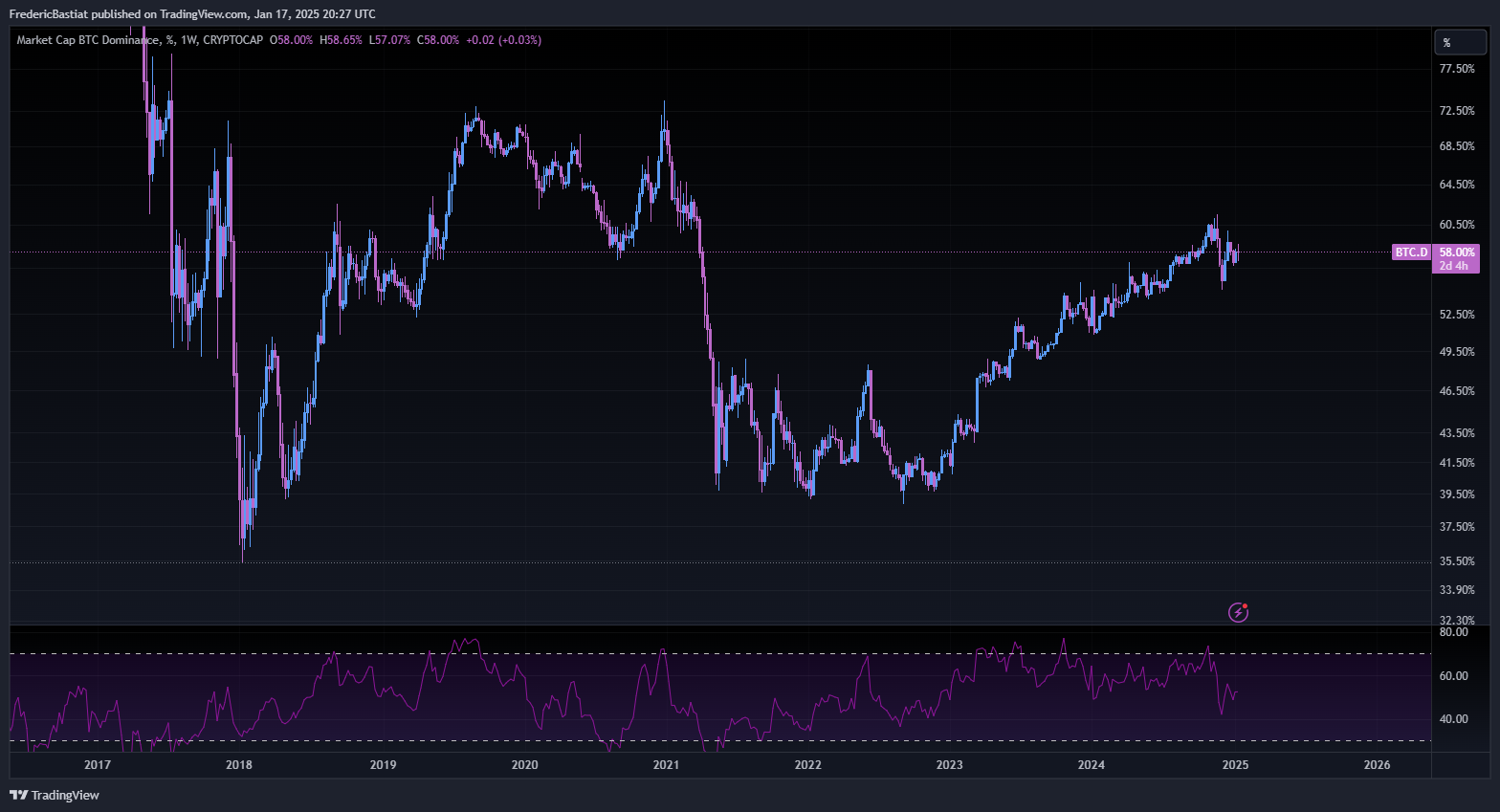This isn’t really the post you think it is. Bear with me.
If you’ve been in the crypto space for long enough, you’re more than familiar with the term “Bitcoin Maxi”. This term describes someone who isn’t pro-crypto, they are pro-Bitcoin, and they will often make sure to define just how import that distinction is to them. Bitcoin, to a maxi, is the one true crypto currency.
Why does such a subset of people exist? Well, as a monetary economist, I would argue Bitcoin maxis are mostly correct. Bitcoin getting the “digital gold” tag isn’t too far off. In short, Bitcoin’s supply is fixed, the mechanics of “mining” that supply closely model gold’s stock-to-flow mechanics, and no one owns it.
Not to mention, it’s also accurate that Bitcoin has been a serious outperformer versus the rest of the crypto market. You can see this via the Bitcoin Dominance chart (BTC.D), where Bitcoin weathers the storm of bear markets and leads the charge of bull markets.

Despite tens of thousands of new coins, memes, and stablecoins, Bitcoin sits pretty at 59% of the total market cap of the entire crypto asset class. One asset has more capital allocated into it than every other competitor in the market, and it’s not even close. If you had sold every altcoin you had for Bitcoin as the 2022 bear market began to set in, you would’ve outperformed your altcoin portfolio by 55% on average. That’s crazy outperformance by investing in a lower-risk asset. No brainer.
With all of this said, I think we’re about to begin the phase of the market cycle where BTC.D goes down. Quickly. The crypto community calls this “Alt Season”. This is where life changing money is made, and often lost. The high of this 6-ish month market environment gets chased for years after the fact, while BTC.D climbs up higher. The altcoin trades people took losses on make new Bitcoin maxis. The spirits of aspiring traders get broken, down 90% on fartcoin. They come to realize sticking with Bitcoin was the better bet all along, and take those lessons with them for the next bull market.
Here’s where I think Bitcoin maxis are wrong, and why I am not one, even though Bitcoin makes up the vast majority of my crypto portfolio.
Cryptocurrency is a bad term to describe the assets. Stocks have prices, and are traded, but these properties don’t make them currency per se. I think that’s why Bitcoin maxis get so disgruntled with the rest of the crypto market. They’ve figured out Bitcoin has unique, money-like properties that no other blockchain tech perfectly matches, so they stick their nose up at any other cryptocurrency. Yet, for most of these other assets, acting as currency really isn’t the aim. They’re better described as blockchain based software companies. These companies, for certain, take monetary economics into account when designing and issuing their assets, but again, that doesn’t mean they’re currency.
Yet, these blockchain based companies are doing incredible things, of very high importance and value. This is where the maxis get it totally wrong. It might have been difficult to fully demonstrate where this is all headed in terms of utility 6 years ago, but it is abundantly clear today. This list could encapsulate 50 more Mirror entries, but I want to highlight a few of my favorite concepts.
Base, Coinbase’s flagship L2 built on Ethereum, has potential within it to scale into an institutional giant. A reality exists where credit card processing runs on base, taking a 3-5% fee to less than a penny per transaction. With Coinbase playing ball with institutions and regulators, Base is a leading candidate for the path to tokenize real world assets. Hello, 24/7 stock market. Of course, Base is also capable of creating environments for DeFi, lending, and more. If successful, Base will create billions of dollars in value that doesn’t exist today. It’s also worth noting that Base isn’t a tradeable asset, which I believe was an incredibly wise choice, and further proves my point that cryptocurrency is a horrible name to describe this novel technology.
Stablecoins are also an incredibly interesting innovation, one that has now seen tens of trillions of dollars in trading volume. Every day, people, institutions, and AI agents are transacting stablecoins over fiat alternatives. This isn’t a cute coincidence, the trading volume has eclipsed that of GDPs of developed nations.
May you also turn your attention to Polymarket, which predicted the election through wagers better than legacy polling companies. Many users don’t even realize that Polymarket is built on blockchain technology. Polymarket is allowing the market to serve as guidance for what is likely to occur, what might be real. In a world where data and narratives manipulate reality and create misinformation, I expect tools like Polymarket to help people determine what is real and what isn’t.
These are a few recent and interesting examples, but the well is deep. You don’t have to search very far to find the real world economic value blockchain technology is creating. Of course, there are scams, memes, NFTs, and all the like. It can be disheartening at times to see the sheer volume of junk and quick-dollar ploys in this market. However, the technology creating actual value will endure, while everything else will fall to the wayside. Despite critiques to the contrary, markets are genuinely good at clearing junk out over time.
Bitcoin paved the way to a new era in banking, finance, and payment systems. It started with Bitcoin, but then came everything else. “Everything else” isn’t a currency the same way that Bitcoin is, but everything else is capable of financial innovation that far exceeds what Bitcoin could do alone.
